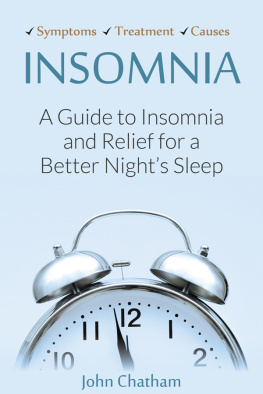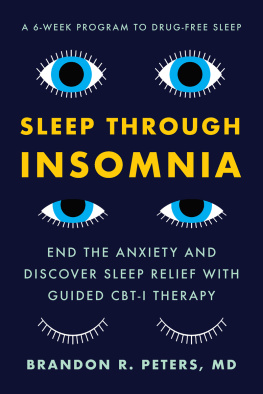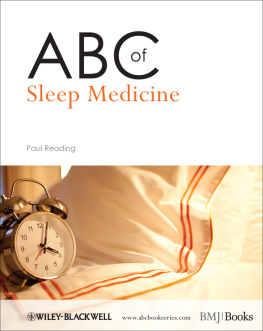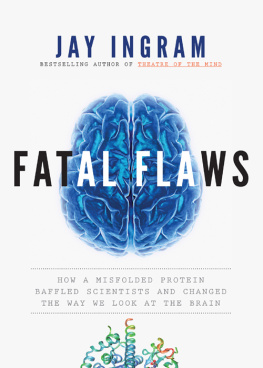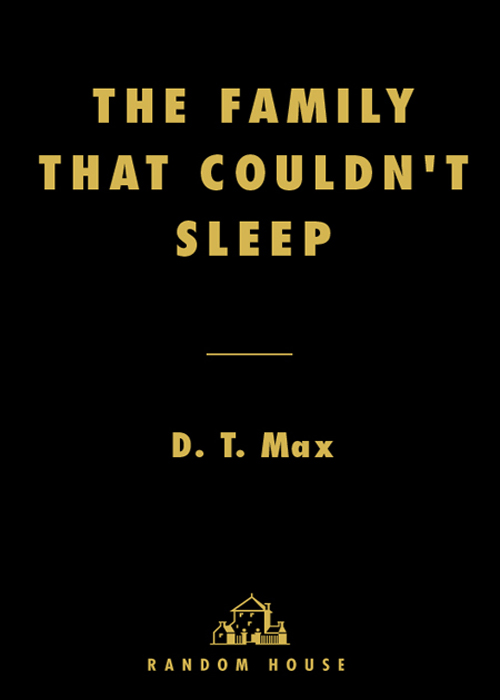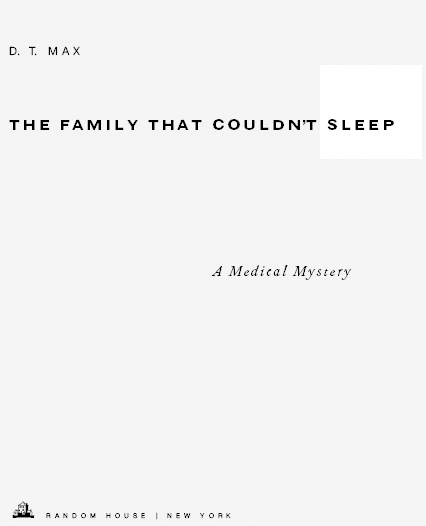D.T. Max - The Family That Couldnt Sleep: A Medical Mystery
Here you can read online D.T. Max - The Family That Couldnt Sleep: A Medical Mystery full text of the book (entire story) in english for free. Download pdf and epub, get meaning, cover and reviews about this ebook. year: 2006, publisher: Random House, genre: Detective and thriller. Description of the work, (preface) as well as reviews are available. Best literature library LitArk.com created for fans of good reading and offers a wide selection of genres:
Romance novel
Science fiction
Adventure
Detective
Science
History
Home and family
Prose
Art
Politics
Computer
Non-fiction
Religion
Business
Children
Humor
Choose a favorite category and find really read worthwhile books. Enjoy immersion in the world of imagination, feel the emotions of the characters or learn something new for yourself, make an fascinating discovery.

- Book:The Family That Couldnt Sleep: A Medical Mystery
- Author:
- Publisher:Random House
- Genre:
- Year:2006
- Rating:4 / 5
- Favourites:Add to favourites
- Your mark:
The Family That Couldnt Sleep: A Medical Mystery: summary, description and annotation
We offer to read an annotation, description, summary or preface (depends on what the author of the book "The Family That Couldnt Sleep: A Medical Mystery" wrote himself). If you haven't found the necessary information about the book — write in the comments, we will try to find it.
What these strange conditionsincluding fatal familial insomnia, kuru, scrapie, and mad cow diseaseshare is their cause: prions. Prions are ordinary proteins that sometimes go wrong, resulting in neurological illnesses that are always fatal. Even more mysterious and frightening, prions are almost impossible to destroy because they are not alive and have no DNAand the diseases they bring are now spreading around the world.
In The Family That Couldnt Sleep, essayist and journalist D. T. Max tells the spellbinding story of the prions hidden past and deadly future. Through exclusive interviews and original archival research, Max explains this storys connection to human greed and ambitionfrom the Prussian chemist Justus von Liebig, who made cattle meatier by feeding them the flesh of other cows, to New Guinean natives whose custom of eating the brains of the dead nearly wiped them out. The biologists who have investigated these afflictions are just as extraordinaryfor example, Daniel Carleton Gajdusek, a self-described
pedagogic pedophiliac pediatrician who cracked kuru and won the Nobel Prize, and another Nobel winner, Stanley Prusiner, a driven, feared self-promoter who identified the key protein that revolutionized prion study.
With remarkable precision, grace, and sympathy, Maxwho himself suffers from an inherited neurological illnessexplores maladies that have tormented humanity for centuries and gives reason to hope that someday cures will be found. And he eloquently demonstrates that in our relationship to nature and these ailments, we have been our own worst enemy.
Advance praise
The Family that Couldnt Sleep is a riveting detective story that plumbs one of the deepest mysteries of biology. The story takes the reader from the torments of an Italian family cursed with sleeplessness to the mad cows of England (and, now, America), following an unlikely trail of misfolded proteins. D. T. Max unfolds his absorbing narrative with rare grace and makes the science sing. Michael Pollan, author of The Omnivores Dilemma and The Botany of Desire
Much has been written about prions and Mad Cow Diseasenearly all of it is worthless. Thankfully, from the world of journalism comes D.T. Max to set things right. Throw all those other Mad Cow books in the trash: This is the book to read about prionsor whatever you want to call them. Its a riveting tale, told by someone with a very special understanding, derived in part from his own strange ailment. Find a cozy spot, clear your schedule and dive in.
Laurie Garrett, author of Betrayal of Trust and The Coming Plague
D. T. Max deftly unfolds the mysterious prion in all its villainous guises. Although scientists do not fully understand these proteinshow they replicate and wreak such havoc in their victims brainsThe Family That Couldnt Sleep reveals their historical, cultural, and scientific place in our world. Prepare to be enlightened, entertained, and frightened.
Katrina Firlik, MD, author of Another Day in the Frontal Lobe
A great book. D.T. Max has drawn the curtain on a cabinet of folly and malady that will stagger your imagination.
Philip Weiss, author of American Taboo
D.T. Max has combined the enthralling medical anthropology of Oliver Sacks with the gothic horror of Stephen King to produce a medical detective story that is as intelligent as it is spooky. The villain of The Family That Couldnt Sleep is the prion, a tiny little protein that causes some of the most terrifying, brain-mangling, creepy diseases known to man. Always fascinatinghow could it not be, given that its characters include cannibals, mad cows, madder sheep, a Nobel prize-winning pedophile, and, most poignantly, an Italian family cursed by fatal insomnia?Maxs book is also a gripping account of scientific discovery, and a heartfelt meditation on what it means to be cursed with an incurable, and brutal, illness. David Plotz, author of The Genius Factory
D.T. Max: author's other books
Who wrote The Family That Couldnt Sleep: A Medical Mystery? Find out the surname, the name of the author of the book and a list of all author's works by series.




